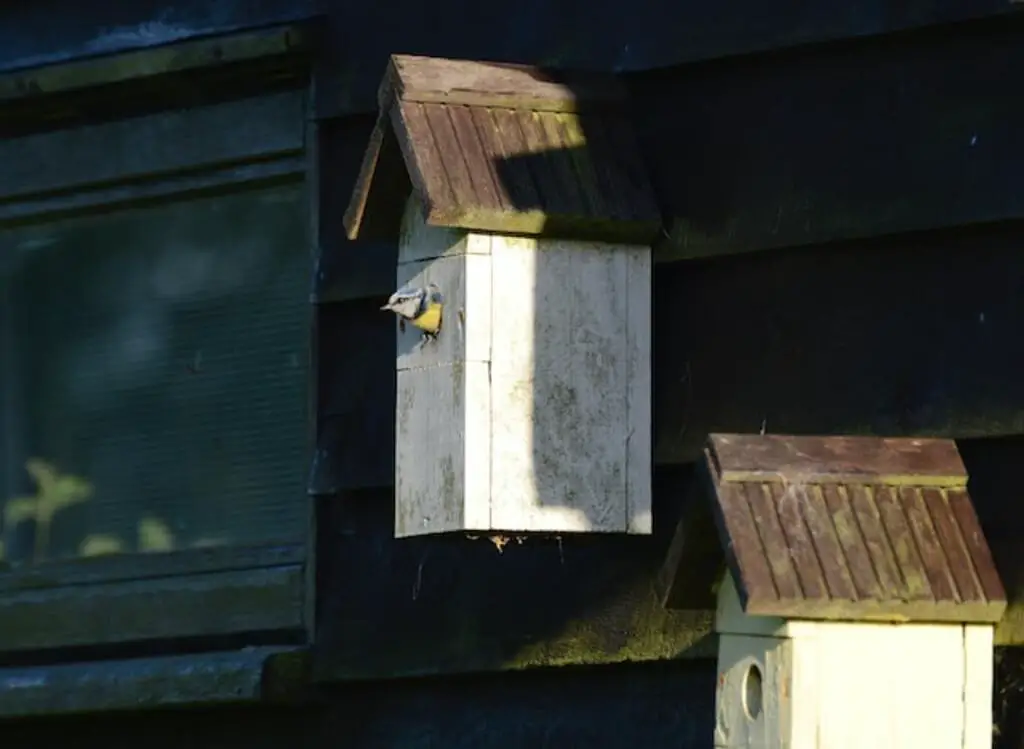As the old adage goes, ‘If you build it, they will come.’ This is especially true when it comes to birdhouses.
A well-placed and maintained birdhouse can attract a variety of bird species to your yard, providing you with the opportunity to observe their fascinating behaviors and beautiful plumage up close.
But simply putting up a birdhouse isn’t enough to guarantee feathered tenants.
There are several factors to consider when learning how to attract birds to your birdhouse, including the type of birdhouse, its placement, the food and water you provide, and the overall environment you create.
In this article, we’ll explore each of these factors in detail, as well as offer tips for attracting specific bird species and troubleshooting common problems that may arise.
Whether you’re a seasoned birder or just starting out, this guide will help you create a bird-friendly oasis in your own backyard.
Table of Contents
- 1 Choosing the Right Kind of Birdhouse
- 2 Setting Up the Birdhouse
- 3 Providing Food and Water
- 4 Creating a Bird-Friendly Environment
- 5 Attracting Specific Bird Species
- 6 Troubleshooting Common Problems
- 7 Frequently Asked Questions
- 7.1 What if birds are not attracted to my birdhouse despite following all the steps?
- 7.2 How often should I clean my birdhouse?
- 7.3 Can I use artificial nesting materials in my birdhouse?
- 7.4 Is it safe to place my birdhouse near my house or other structures?
- 7.5 What should I do if predators like squirrels or cats are attacking my birdhouse?
- 8 Conclusion
- 9 Author
Choosing the Right Kind of Birdhouse
When it comes to attracting birds to your backyard, choosing the right kind of birdhouse is crucial.
There are several factors to consider, such as the size and shape of the birdhouse, the type of bird you want to attract, and the location where you’ll place it.
Different types of birdhouses offer unique advantages, so it’s important to know which one will work best for your feathered friends.
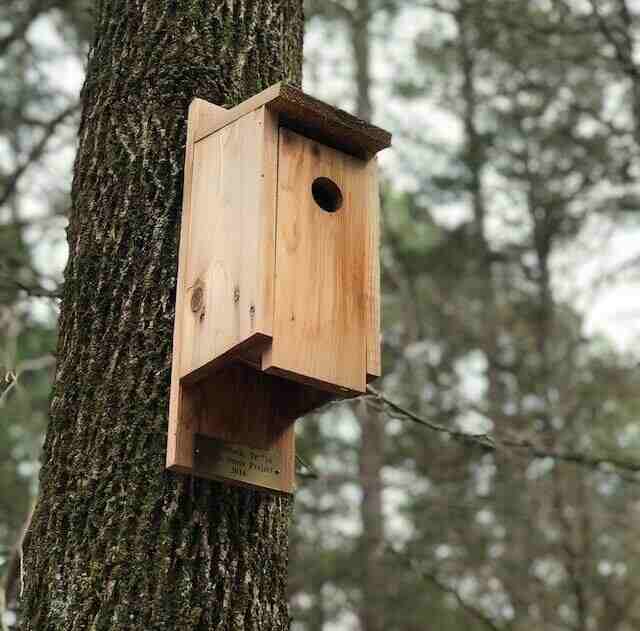
Factors to Consider When Choosing a Birdhouse
Choosing the perfect home for your feathered friends can be overwhelming, but don’t worry, with a little research and some patience, you’ll find a birdhouse that will make them feel like royalty.
When considering factors to choose the right birdhouse, size matters. Ensure that the birdhouse you choose is of the right size for the bird species you want to attract.
Also, consider the entrance hole size. If the hole is too large, it might attract unwanted visitors like squirrels, but if the hole is too small, birds might not be able to enter.
Material durability is also crucial, as the birdhouse needs to withstand harsh weather conditions. The birdhouse should be made of weather-resistant materials such as wood, metal, or plastic.
With these factors in mind, you can choose the best birdhouse for your feathered friends.
In the next section, we’ll explore different types of birdhouses and their advantages.
| Factor | Consideration |
|---|---|
| Size | Choose a birdhouse with appropriate dimensions that suit the target bird species’ size and nesting requirements |
| Entrance Hole | Ensure the entrance hole size is suitable to allow the desired bird species to enter while keeping out predators |
| Material | Select a birdhouse made of durable and weather-resistant material for longevity and protection |
| Ventilation | Check for adequate ventilation holes or gaps to regulate temperature and prevent moisture buildup |
| Drainage | Ensure the birdhouse has proper drainage holes to prevent water from accumulating inside |
| Accessibility | Make sure the birdhouse is easy to open and clean for regular maintenance |
| Mounting Options | Consider different mounting options, such as hanging, pole-mounted, or tree-mounted, based on your preference |
Different Types of Birdhouses and Their Advantages
Get ready to discover the ultimate abodes for your feathered buddies—from cozy wooden cottages to sleek metal mansions, these birdhouses will have you swooning!
When it comes to attracting birds to your birdhouse, the type of house you choose can make all the difference.
Decorative designs are a great way to add a touch of personality to your backyard, while material options like wood, metal, and plastic can provide different levels of durability and insulation.
For those who love a good DIY project, building your own birdhouse can be a fun and rewarding experience.
No matter which type of birdhouse you choose, it’s important to make sure it’s set up in the right location to ensure the birds feel safe and comfortable.
| Birdhouse Type | Advantages |
|---|---|
| Nest Box | – Provides sheltered space for cavity-nesting birds |
| – Can attract various species depending on the size of the entrance hole and design | |
| – Offers protection from predators and adverse weather conditions | |
| Platform | – Suitable for open-nesting birds that prefer an exposed nesting site |
| – Allows easy access and monitoring of the nesting activities | |
| – Provides a larger nesting area, accommodating larger bird species | |
| Hanging | – Can be suspended from a tree branch, hook, or pergola, attracting a wide range of bird species |
| – Keeps the birdhouse out of reach of some ground predators | |
| – Offers a swinging motion, which may deter certain predators | |
| Gourd | – Provides a unique and decorative nesting option |
| – Attracts cavity-nesting birds that prefer enclosed spaces | |
| – Offers natural ventilation and drainage due to the gourd’s shape | |
| Window | – Allows for up-close observation of nesting birds and their behaviors |
| – Provides educational opportunities and entertainment for bird enthusiasts | |
| – May attract birds that are accustomed to nesting near human activity |
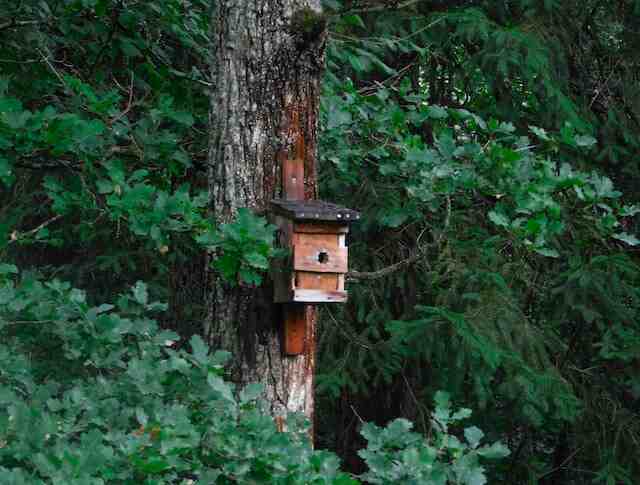
Setting Up the Birdhouse
Setting up the birdhouse is a crucial part of attracting birds to your backyard. Proper location and placement of the birdhouse can make all the difference in whether or not birds will inhabit it.
Additionally, protecting the birdhouse from predators is essential to ensure the safety of the birds and their young. By following these key points, bird enthusiasts can create a safe and inviting home for their feathered friends.
Location and Placement of the Birdhouse
Now, it’s all about finding the perfect spot for your feathered friends’ new home – a place where they can feel safe and cozy, like a warm hug on a chilly day.
When selecting a location for your birdhouse, there are a few things to keep in mind. First, consider the landscaping around your house. Birds are attracted to areas with plenty of vegetation, so try to place your birdhouse near trees or shrubs.
Next, think about weather considerations. Make sure the birdhouse is sheltered from strong winds and direct sunlight.
Finally, pay attention to bird migration patterns. If you want to attract a specific type of bird, research their migration patterns and place the birdhouse in an area where they are likely to stop.
By carefully selecting the location and placement of your birdhouse, you can create a welcoming environment that birds will flock to.
As you consider the next step in protecting your birdhouse from predators, remember that placement is key to keeping your feathered friends safe.
| Consideration | Guidelines |
|---|---|
| Habitat and Species | – Research the habitat preferences and nesting habits of the bird species you want to attract |
| – Choose a location that resembles the natural habitat of the bird species | |
| – Consider the bird’s nesting preferences and specific habitat requirements | |
| – Provide suitable food sources, water, and nearby vegetation for nesting materials |
Protecting the Birdhouse from Predators
To keep those pesky predators at bay, you’ll want to take some steps to protect the home of your avian companions.
The first step is to install predator guards on the pole or tree where the birdhouse is mounted.
These guards can be cone-shaped or disk-shaped and will prevent predators such as squirrels, raccoons, and snakes from climbing up the pole or tree and accessing the birdhouse.
Another effective method is to use decoys such as fake owls or snakes to scare off potential predators. These decoys can be placed near the birdhouse or on the ground around the pole or tree.
Lastly, motion-activated deterrents such as sprinklers or lights can also be used to startle predators and keep them away from the birdhouse.
By taking these preventative measures, you can ensure the safety of your feathered friends and increase the likelihood of attracting more birds to your birdhouse.
Now, let’s move on to the next step of providing food and water for your avian visitors.
| Consideration | Guidelines |
|---|---|
| Predator Guards | – Use baffles or predator guards to deter climbing animals |
| – Ensure the entrance hole size is appropriate to prevent larger predators from entering | |
| – Choose a location that offers protection from potential predators and minimizes access points | |
| – Ensure good visibility for birds while reducing the risk of predation |
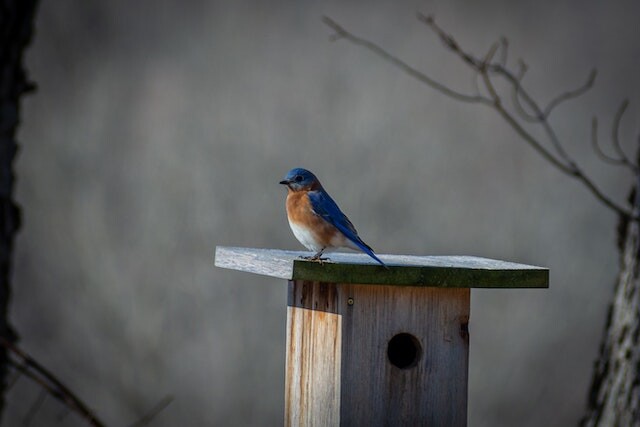
Providing Food and Water
Providing food and water is crucial for attracting and keeping birds in your birdhouse. It’s important to know the best types of food for birds.
Additionally, understanding the significance of water for birds and how it can attract them to your birdhouse is crucial.
Best Types of Food for Birds
If you want to entice feathered friends to visit your little abode, offering the best types of food is key. Bird food options are plentiful, with seeds, nuts, fruits, and insects all being popular choices.
However, it’s important to consider the feeding frequency of your chosen food, as some birds may need to eat more frequently than others.
Additionally, if you’re looking to attract rare species, it’s helpful to research their specific dietary needs and offer those foods accordingly.
It’s also important to note that providing a variety of foods can attract a wider variety of birds.
Ensuring that your birdhouse is always stocked with fresh, high-quality food will not only attract more birds, but also keep them healthy and happy.
As important as food is, it’s also crucial to provide a source of water for your feathered friends.
| Food Type | Description |
|---|---|
| Seeds | Provide a variety of seeds such as sunflower, safflower, and nyjer seeds |
| Fruits | Offer fresh fruits like berries, apples, and oranges, cut into small, manageable pieces |
| Nectar | Attract hummingbirds with nectar feeders filled with a sugar-water solution |
| Insects and Mealworms | Provide live or dried insects and mealworms, which are rich in protein |
| Suet | Offer suet cakes or blocks made from animal fat mixed with seeds, fruits, or insects |
| Nuts | Place nuts like peanuts or almonds in feeders or on feeding platforms |
Importance of Water for Birds
Now that you know what types of food to offer birds, it’s important to consider their water needs. Hydration is just as crucial for birds as it is for humans, and having a source of clean water can attract water-loving birds to your yard.
There are various bird bath options available, from simple shallow dishes to elaborate fountains. Providing a bird bath not only benefits the birds, but also adds a beautiful element to your garden.
Some birds may also use the water for bathing and preening, which helps to maintain their feathers. By attracting water-loving birds, you’re creating a diverse and thriving ecosystem in your yard.
So, now that you have the food and water covered, let’s move on to creating a bird-friendly environment.
| Importance of Water | Description |
|---|---|
| Drinking | Birds need water for drinking to stay hydrated. Providing a shallow water source is essential for their well-being. |
| Bathing | Birds use water for bathing to keep their feathers clean and in good condition. |
| Cooling | During hot weather, birds may cool off by splashing or wading in water. |
| Social Interaction | Water sources can attract multiple bird species, providing opportunities for social interaction and observation. |
| Attracting Birds | A reliable water source in your yard can help attract a diverse range of bird species. |
| Year-Round Importance | Water is essential for birds throughout the year, not just during specific seasons. |
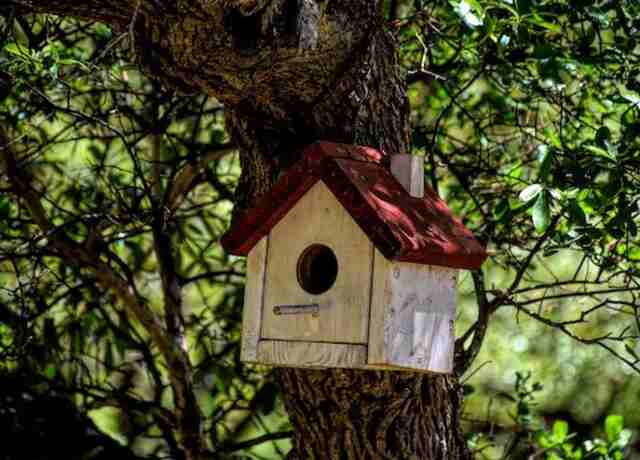
Creating a Bird-Friendly Environment
Creating a bird-friendly environment is crucial to attracting and maintaining a diverse range of bird species in your backyard.
Planting flowers and trees that produce berries, fruits, and nectar provides a natural food source for birds while also adding beauty to your yard.
Additionally, maintaining a clean and safe environment free of predators, toxic chemicals, and clutter ensures that birds feel comfortable enough to make your yard their home.
Planting Flowers and Trees to Attract Birds
Planting flowers and trees can be a beautiful and natural way to entice feathered friends to visit your outdoor space.
To attract birds, it’s important to choose native species that are adapted to the local climate and provide food and shelter.
Color schemes should also be considered, as birds are attracted to bright, bold colors such as red, orange, and yellow.
Seasonal planting is also important. Different plants bloom at different times of the year and provide food and nesting materials for birds.
Trees are crucial for birds as they provide shelter, nesting sites, and perches for birds to rest and survey their surroundings.
Overall, planting flowers and trees is an effective way to attract birds to your birdhouse and create a beautiful outdoor space. Maintaining a clean and safe environment for birds is also essential to ensure their continued presence in your space.
| Benefits of Planting | Guidelines |
|---|---|
| Native Plants | – Choose native plants that provide food and shelter |
| – Research plants that attract specific bird species | |
| – Plant a variety of flowers, shrubs, and trees | |
| – Create different levels of vegetation for nesting | |
| Food Sources | – Select plants that produce fruits, seeds, or nectar |
| – Provide plants with staggered blooming periods | |
| – Include plants with different colors and sizes | |
| – Plant flowering plants in sunny areas | |
| Shelter and Cover | – Plant dense shrubs and bushes for nesting sites |
| – Incorporate trees with branches for perching | |
| – Create a diverse landscape with varying heights | |
| Water Sources | – Install birdbaths or shallow water containers |
| – Keep water sources clean and refreshed | |
| – Provide a shallow area for birds to bathe |
Maintaining a Clean and Safe Environment
Keeping a tidy and secure outdoor space is crucial for the health and well-being of our feathered friends. To maintain a clean and safe environment, it’s important to take the following steps:
- Regularly inspect the birdhouse for any signs of damage or wear and tear that could put the birds at risk.
- Clean the birdhouse regularly by removing old nesting material, droppings, and any debris that may accumulate inside.
- Ensure that the birdhouse is located in an area that’s free from any potential predators or hazards that could harm the birds.
- Finally, prevent disease transmission by regularly disinfecting the birdhouse and any surrounding areas.
By following these simple steps, you can help ensure that your birdhouse provides a safe and secure environment for our feathered friends.
In the next section, we’ll discuss how you can attract specific bird species to your birdhouse.
| Importance of Maintenance | Guidelines |
|---|---|
| Prevent Disease | – Clean birdhouses regularly to remove parasites or mold |
| – Dispose of any decaying food or waste nearby | |
| – Replace old nesting materials with fresh ones | |
| – Monitor for signs of disease or infection in birds | |
| Predation Prevention | – Remove potential hiding spots for predators |
| – Trim branches or vegetation that could aid predators | |
| – Install predator guards or baffles on birdhouses | |
| – Place feeders and birdhouses away from dense cover | |
| Safe Surroundings | – Eliminate or secure any hazards or potential dangers |
| – Avoid using pesticides or chemicals in the area | |
| – Minimize noise and disturbance around the birdhouse | |
| – Provide a clear flight path to and from the birdhouse |

Attracting Specific Bird Species
Attracting specific bird species can be a rewarding experience for any bird lover. To attract bluebirds to your birdhouse, it’s important to provide nesting materials, a clean and secure environment, and specific types of food.
Similarly, attracting cardinals, chickadees, and other common birds can be achieved through understanding their unique needs and preferences, and creating an inviting habitat that meets those needs.
With a little bit of effort and knowledge, anyone can create a bird-friendly environment that attracts their favorite feathered friends.
Tips for Attracting Bluebirds to Your Birdhouse
If you want to see a flash of blue darting through your backyard, try these tips for luring in these beautiful feathered creatures.
Bluebirds are attracted to specific types of birdhouses, so make sure yours meets their requirements. Bluebird nesting boxes should be mounted on poles or trees, facing open fields or meadows.
Mealworm feeders are also a great addition to your yard, as bluebirds love to snack on these protein-packed treats.
Additionally, consider landscaping your garden with plants that provide bluebirds with natural food sources, such as berry bushes and fruit trees.
By following these tips, you’ll be sure to attract bluebirds to your yard in no time.
And if you’re interested in attracting cardinals, chickadees, and other common birds, there are plenty of other strategies to explore.
Attracting Cardinals, Chickadees, and Other Common Birds
Well, it looks like we’ll just have to sit back and wait for those elusive, rare birds to grace us with their presence while we enjoy the company of the boring old cardinals and chickadees.
But, just because these birds are common doesn’t mean they’re any less fascinating to watch.
To attract cardinals, it’s important to provide nesting materials such as twigs, grass, and leaves and offer a platform-style birdhouse with a larger entrance hole.
Chickadees, on the other hand, prefer birdhouses with a small entrance hole and will appreciate nesting materials such as moss, feathers, and animal hair.
Other common birds such as sparrows and finches enjoy bird baths, so providing a source of water in your yard can also attract these species.
Identifying bird species and catering to their specific needs is key in attracting a variety of birds to your birdhouse. Next, let’s discuss troubleshooting common problems with birdhouses.
Here’s a table listing some common backyard bird species, the type of birdhouse they prefer, the recommended hole size, and the nesting materials they use:
| Bird Species | Type of Birdhouse | Hole Size (inches) | Nesting Materials |
|---|---|---|---|
| Eastern Bluebird | Nest box | 1 ½” | Grasses, pine needles, feathers, and fine twigs |
| House Wren | Nest box or gourd | 1 ⅛” | Twigs, grasses, feathers, and hair |
| Chickadee | Nest box | 1 ⅛” | Moss, fur, plant fibers, and feathers |
| Purple Martin | Martin house | 2 ¼” – 2 ½” | Pine needles, leaves, feathers, and grass |
| Tree Swallow | Nest box | 1 ½” | Feathers, grasses, leaves, and pine needles |
| Northern Flicker | Nest box or snag | 2 ½” – 3 ½” | Wood chips, bark, and feathers |
| American Robin | Platform or shelf | Open | Mud, grass, twigs, and sometimes paper |
| Barn Owl | Nest box | 6″ x 6″ | Pellets and soft materials for lining |
| House Sparrow | Nest box | 1 ¼” | Various materials including straw and feathers |
| European Starling | Nest box or cavity | 1 ⅜” | Various materials including straw and feathers |
Please note that the table is not exhaustive, and different bird species may have varying preferences and requirements. Adjustments to the hole size and nesting materials may be needed for specific species.
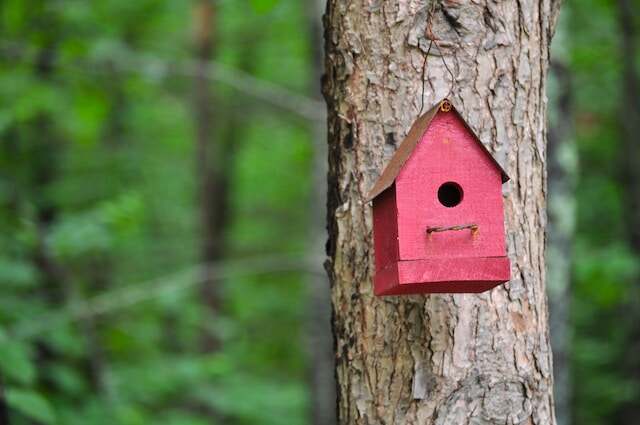
Troubleshooting Common Problems
When it comes to attracting birds to your birdhouse, it’s not uncommon to encounter some unwanted visitors. However, dealing with such birds can be a tricky task.
One must also ensure that the birdhouse is properly cleaned and maintained to keep the birds healthy, and to encourage them to continue visiting.
With a little bit of knowledge and effort, you can address these common problems and create a thriving birdhouse that will attract a variety of beautiful birds.
Dealing with Unwanted Birds
To prevent unwanted feathered guests from taking over your cozy abode, try installing a predator guard or using wire mesh around the entrance.
These measures will keep larger birds such as pigeons and crows out, while still allowing smaller birds like finches to enter.
Scaring sparrows away can also be done by using reflective surfaces or fake predators like owls.
It’s important to remember that not all birds are pests, and some may simply be looking for a place to rest. However, if you do find yourself with unwanted visitors, these methods can help.
Once you’ve ensured that only the birds you want are using your birdhouse, it’s important to keep it clean and maintained to ensure their safety and comfort.
Cleaning and Maintaining Your Birdhouse
Now that you know how to deal with unwanted birds, it’s time to focus on keeping your birdhouse clean and well-maintained to attract the birds you want.
Effective cleaning is crucial to prevent the buildup of mold and bacteria that can harm birds. Regular maintenance is also necessary to ensure that the birdhouse remains sturdy and safe for birds to inhabit.
To achieve this, here are some tips:
- Use a mild soap and water solution to clean the birdhouse thoroughly, making sure to remove any debris or droppings.
- Rinse the birdhouse with clean water and let it dry completely before putting it back up.
- Check the birdhouse regularly for any signs of damage or wear and tear, and make repairs as needed.
- Prevent mold growth by placing the birdhouse in a location with good ventilation and sunlight.
- Use a birdhouse guard to prevent predators from accessing the birdhouse.
By following these tips, you can ensure that your birdhouse remains a safe and inviting place for birds to nest.
In the next section, we’ll discuss the importance of choosing the right location for your birdhouse.
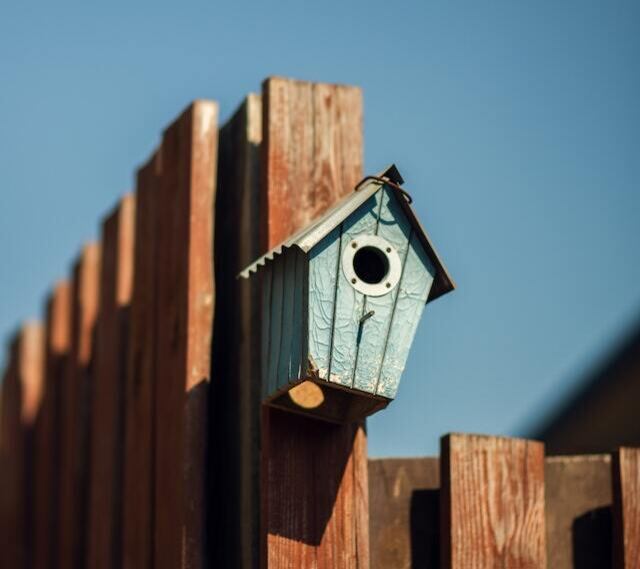
Frequently Asked Questions
What if birds are not attracted to my birdhouse despite following all the steps?
So, you’ve followed all the steps to attract birds to your birdhouse, but your feathered friends are still nowhere to be found.
Don’t fret, there could be a number of reasons why your birdhouse is not the hotspot you thought it would be.
First, let’s talk about location. Are you sure your birdhouse is in a spot that birds actually frequent?
Remember, they like areas that are sheltered from predators but still offer easy access to food and water sources.
Speaking of food, are you providing a variety of birdseed and suet to entice different bird species?
Lastly, let’s not forget about the design of your birdhouse. Is it the right size and shape for the birds you want to attract? Does it have the right amount of ventilation and drainage?
Keep tinkering with these factors and eventually, you’ll get your birdhouse buzzing with activity.
How often should I clean my birdhouse?
Cleaning frequency is an important aspect of maintaining a birdhouse. Regular cleaning ensures the safety and health of the birds.
The frequency of cleaning varies depending on the birdhouse’s location, the number of birds using it, and the weather conditions.
A good rule of thumb is to clean the birdhouse at least once a year, preferably in the fall after the birds have migrated.
To clean the birdhouse, remove any old nesting materials, scrub the interior with warm water and mild soap, and rinse thoroughly. Be sure to wear gloves and a mask to protect yourself.
Proper birdhouse placement is crucial to attracting birds. Place the birdhouse in a quiet, shaded area away from predators and traffic.
With the right maintenance tips and cleaning frequency, your birdhouse will be a welcoming home for birds year after year.
Can I use artificial nesting materials in my birdhouse?
Artificial nesting materials in birdhouses? Sure, why not? After all, it’s not like birds have been building their own nests for millions of years or anything.
But before you start stuffing your birdhouse with polyester fibers and plastic grass, let’s weigh the pros and cons.
On the one hand, artificial materials are readily available, easy to clean, and can provide a uniform, tidy appearance.
On the other hand, they may not be as effective at insulating eggs and chicks from the elements, and may not provide the natural texture and scent that birds are accustomed to.
Alternative options include using natural materials such as grasses, leaves, and twigs, or even leaving the birdhouse empty and letting the birds do the work themselves.
Ultimately, the effectiveness comparison of different nesting materials may vary depending on the species of bird, the location of the birdhouse, and other factors. So, experiment and see what works best for you and your feathered friends!
Is it safe to place my birdhouse near my house or other structures?
Placing a birdhouse near your house or other structures can be a great idea, as long as it’s done safely.
There are several benefits to placing birdhouses near water, such as attracting birds that require a water source for drinking and bathing.
Additionally, using different types of birdhouses can attract a wider variety of bird species.
When positioning the birdhouse, it’s important to consider shading, as birds prefer cooler areas during hot weather.
By taking these factors into account, you can create a safe and inviting environment for birds to nest and thrive.
What should I do if predators like squirrels or cats are attacking my birdhouse?
When predators like squirrels or cats are attacking your birdhouse, it’s important to take action to protect the birds and their habitat.
One effective solution is to install predator guards on the birdhouse itself or on the pole supporting it. These guards can prevent predators from climbing up and gaining access to the birdhouse.
If this doesn’t work, consider relocating the birdhouse to a safer location, away from trees or other structures that predators can use to reach it.
Another option is to use bird-safe deterrence methods, such as hanging shiny objects or using motion-activated sprinklers.
By taking these precautions, you can help ensure that your birdhouse is a safe haven for birds in your area.
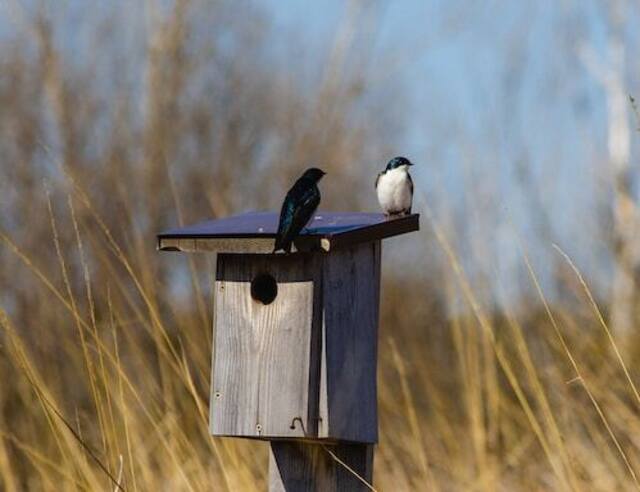
Conclusion
In conclusion, there are several key tips to keep in mind when attracting birds to your birdhouse. These tips include providing food, water, and shelter, as well as maintaining a clean and safe environment.
Encouraging bird-watching and conservation efforts can also help to promote a healthy and thriving bird population in your area.
By following these tips and taking an active role in supporting bird habitats, you can help to create a more vibrant and sustainable ecosystem for birds and other wildlife.
Recap of Tips for Attracting Birds
Recapping the tips for drawing avian visitors to your nesting spot can increase the likelihood of feathered friends taking up residence.
First, consider the common bird species in your area and tailor your birdhouse design to meet their needs.
Next, ensure proper birdhouse placement, which includes the right height, distance from other birdhouses, and orientation.
Lastly, create a bird-friendly environment by providing food, water, and shelter, and by reducing the use of pesticides and other harmful chemicals.
These small steps can make a big difference in attracting birds to your backyard.
By providing a safe and inviting environment, you can encourage bird-watching and conservation, ultimately leading to a better understanding and appreciation of these beautiful creatures.
Encouraging Bird-Watching and Conservation
You can deepen your appreciation of these beautiful creatures by fostering a bird-friendly environment, encouraging their presence and promoting conservation efforts.
Bird watching benefits not only the birds, but also the watcher, as it provides an opportunity to connect with nature and learn about different species.
By attracting birds to your birdhouse, you can create a safe haven for them and contribute to their conservation efforts.
It is essential to understand the environmental impact of human activities on birds and take steps to mitigate them.
Incorporating native plants, reducing pesticide use, and minimizing light pollution are some ways to create a bird-friendly environment.
By promoting conservation efforts, such as supporting organizations that protect birds and their habitats, you can make a significant impact on their survival.
The table below provides some examples of bird-friendly practices that can be incorporated into your daily life.

